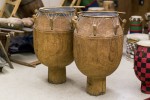Two large barrel drums sat side by side in the ethnomusicology department, representing the musical culture of African villages from which they originated.
The drums are called Atumpan, considered a Ghanaian talking drum due to its ability to imitate language. In 1965, they journeyed to UCLA from Ghana through a musical collaboration between Mantle Hood, the founder of the ethnomusicology department, and Joseph Hanson Kwabena Nketia from the Institute of African Studies at the University of Ghana.
Pablo Infante-Amate, an ethnomusicology graduate student with a focus on African music, said the ethnomusicology department encourages bi-musicality, or learning how to play the instruments students learn about in class.
Infante-Amate said the department invested a substantial amount money to buy new instruments, maintain the instruments, and hire respectful teachers. Since the drums were acquired, the department hired skilled players to teach the African drums.
“Every teacher that teaches at the ensembles is a native to their culture,” Infante-Amate said.
Infante-Amate said the Atumpan, one of the main drums in an ensemble of the Akan people of Ghana, can be played alone or part of larger ensembles, like the fontomfrom ensemble.
The two drums, played for dance, communication and language, have different pitches and tones. Infante-Amate said they are played with sticks and are considered talking drums because they can imitate sounds of some African languages, like the Ewe language.
In African villages, Infante-Amate said, Atumpan drums were not only used in a musical setting, but also to express the tones of proverbs, and to communicate messages and deliver important news from one village to another.
The Ghanaian drums were brought to UCLA three years after Hood visited Ghana in 1962. Infante-Amate said Hood purchased the fontomfrom ensemble after learning about the Ghanian drums from Nketia.
Infante-Amate said Hood then revisited Ghana to make his 1964 documentary called “Atumpan,” which depicted the history and culture behind the large drums and their deep relationships to Ghanian villages.
Infante-Amate said after the documentary was made, Nketia came to UCLA as a visiting lecturer in 1963. He went on to become a Professor of Music, working from 1968 to 1983 to teach ethnomusicology students about the drums and culture.
Infante-Amate said African drumming is slightly different from other types of drumming, due to its intricate and polyphonic layers of sound. Students in the African ensemble classes learn how to play the drums from native musicians.
“I try to be very respectful of the tradition and what it represents in its original place,” Infante-Amate said.
